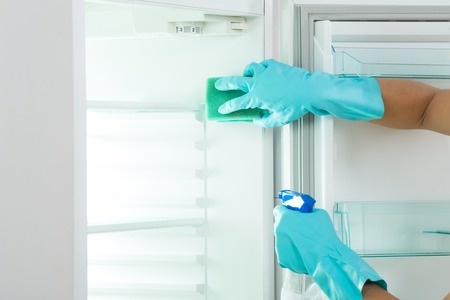- Clean Home
- Kitchen Cleaning & Organizing
- Fridge Odor Removal Tips
Fridge Odor Removal Tips
Nothing says "ick" quite like a nasty fridge odor. You need some fridge odor removal tips.
Whether the sushi went south last month or you need to neutralize the everyday accumulation of bad smells in your refrigerator, odor removal starts with a quick cleaning out and cleaning up of your fridge's interior.
These fridge odor removal tips can bring back a fresh, clean smell to your refrigerator.
Fridge Odor Removal Tips Start With Removing Everything
Examine everything inside the refrigerator carefully as you remove it, even if you've already identified the cause of your fridge odor.
Keep what appears to be edible; toss what's gone south.
Clean the Fridge's Interior Surfaces
Dissolve four teaspoons baking soda in one-quart water.
With a soft, clean cloth, wash all interior surfaces of the refrigerator, including the top, bottom, drawers, and walls. Rinse surfaces with warm water. Dry with a soft, clean cloth.
Fill the Interior with Newspapers
Pack the refrigerator, including the doors and drawers, with crumpled sheets of newspaper. (Black and white only - no color pages.)
Place charcoal briquettes or coffee grounds randomly throughout the newspaper to soak up those bad smells. Let stand 24 to 48 hours.
Remove the charcoal briquets, coffee grounds, and newspapers. Wash all interior surfaces with a rag moistened with liquid dishwashing detergent mixed with water.
Pay special attention to corners and crevices to remove any lingering fridge odor.
Fridge Odor Removal Tips For Prevention
Used correctly, your refrigerator will keep food safe from spoilage and bacteria, and all your fridge smells should be of the positive (dinner!) variety.
Misused, it could cause big trouble of the tummy kind - and fridge odor. Essentially, no food benefits from storage. You want to eat everything as fresh as you can.
But since we can't all tromp out to the garden to harvest produce for each meal, here are some guidelines for making your fridge function at its best while keeping fridge odor at bay.
- To keep food from spoiling in the refrigerator, the temperature needs to be between 34 degrees F and 40 degrees F. You can't depend on the little gauge (1-5) in the fridge. Buy a refrigerator thermometer.
 The door is the warmest part of the refrigerator; this is the best place for nonperishables (sodas).
The door is the warmest part of the refrigerator; this is the best place for nonperishables (sodas).- Some parts of your refrigerator are colder than others. The meat compartment at the bottom is designed to store meat, so put meat there. Not only is this the coldest area, but if a package leaks, it won't contaminate other foods - and cause odors.
- The door is the warmest part of the refrigerator. This is the best place for nonperishables (sodas) - not perishables like eggs.
- Don't put hot food in the refrigerator. Bring it to room temperature before refrigerating it. Hot food can cause refrigerator temperatures to drop.
- On the other hand, don't leave food out too long, either. Refrigerate prepared food within two hours of cooking (one hour in the summer.)
- To prevent future odors, remember always to wipe up spills immediately to keep bacteria from growing. It's those growths - furry or otherwise - that cause bad smells here. Wash spilled areas with soapy water; then disinfect with a solution of 1 teaspoon of bleach in 1 quart of water.
- Don't overload the refrigerator. Parties are a dangerous time because you cram a lot of food into the fridge, and then you're continually opening the door. Turn the temperature down during these occasions to keep the food cold.
- Cover foods tightly. Leave meats in their original packaging to prevent spreading bacteria.
- If you lose power, do not open your refrigerator or freezer. If the door is not opened, food should keep eight hours in the refrigerator and 48 hours in the freezer.
- Weekly, do a more thorough cleaning. Examine the contents inside and check expiration dates. Toss those items past their prime. Rotate food and condiments so that the oldest of
any item (milk, for example) is front and center when little hands are
searching.
- Deep clean monthly. First, unplug for safety. Remove all food. Dissolve four teaspoons of baking soda in 1 quart of water. Use a soft, clean cloth to wash all interior surfaces. Be sure to hit the top, bottom, drawers, and walls. Pay special attention to corners and crevices.
- Finish by rinsing surfaces clean with warm water. Dry with a soft, clean cloth and place an opened box of baking soda on a low shelf as your first defense against future bad smells here.
- Clean Home
- Kitchen Cleaning & Organizing
- Fridge Odor Removal Tips








